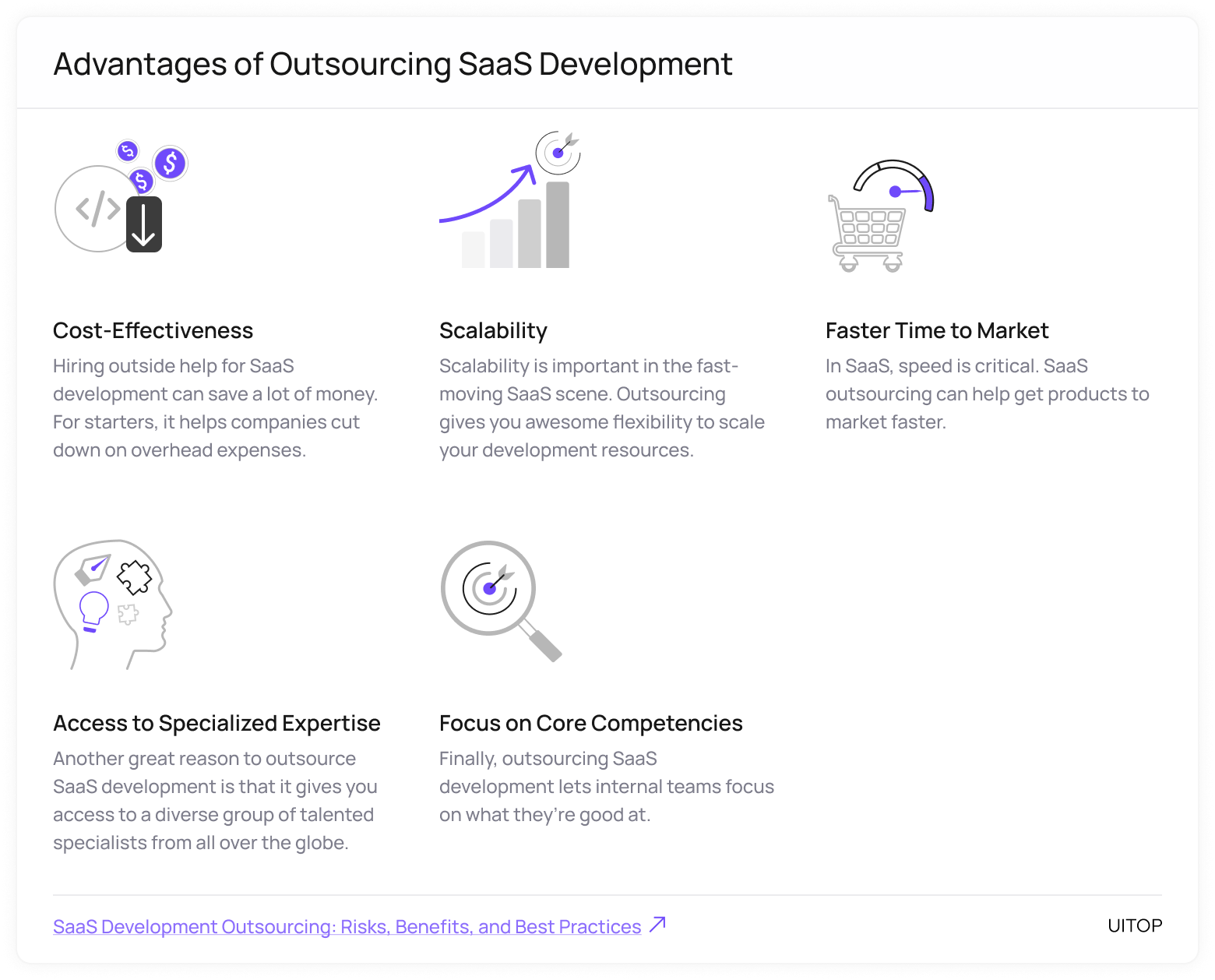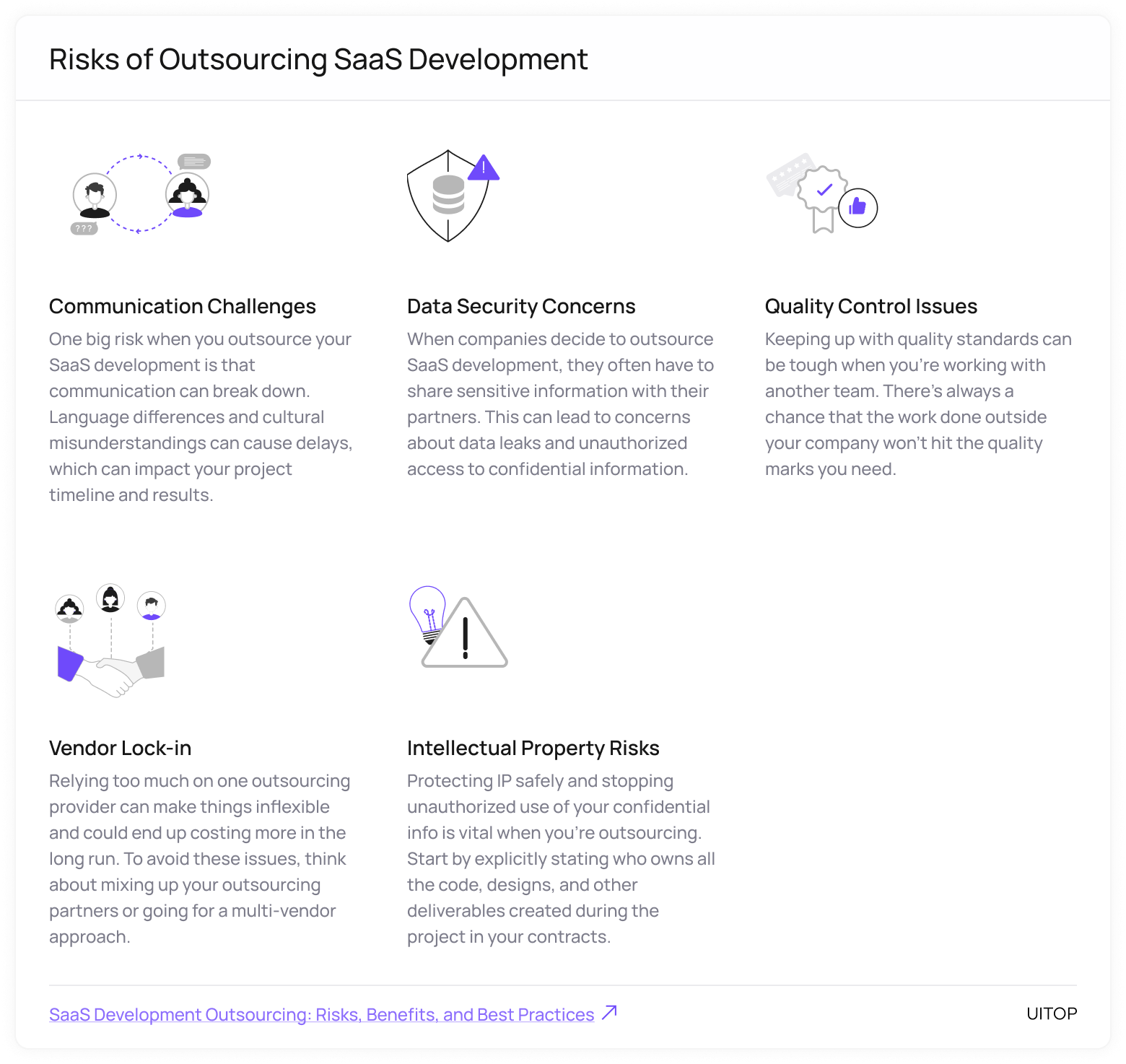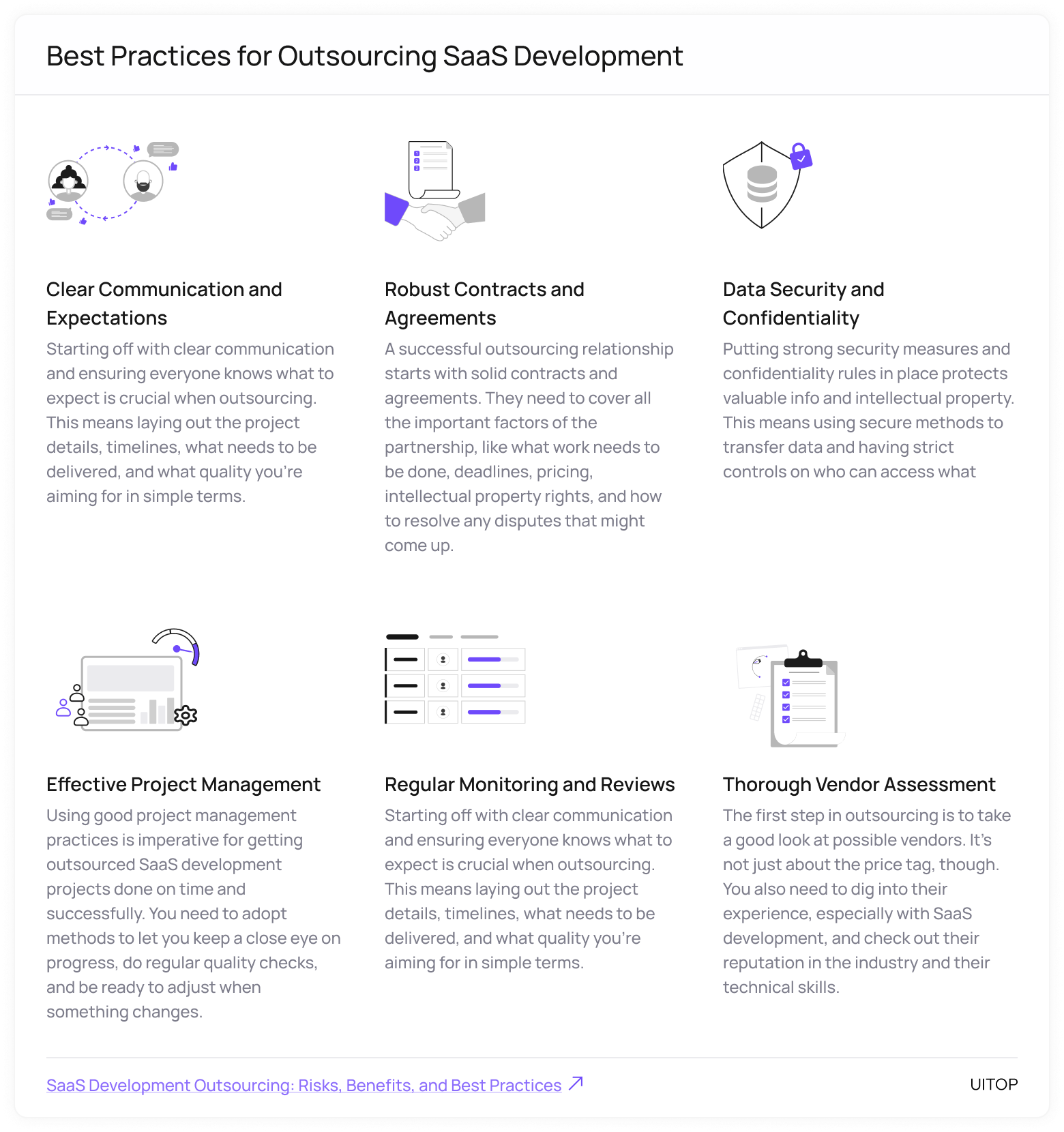What is SaaS?
If you're just beginning to research the idea of SaaS, this is the place to understand what SaaS can accomplish for you, how it works and differs, what are the main examples and what the future holds for SaaS development.
With more companies choosing to create software as a service (SaaS) solutions, a lot of them are thinking about outsourcing SaaS development. It’s about hiring outside service providers to help build, manage, or improve software that’s hosted in the cloud and used online through a subscription. This decision can bring benefits like saving money and tapping into specialized skills. But it can also have some risks.
In this article, we’ll explore the pros and cons of outsourcing SaaS development and share some useful tips for businesses that want to make this option work.
Outsourcing SaaS development can totally change the game for a lot of businesses. Let’s look at these benefits more closely.

Hiring outside help for SaaS development can save a lot of money. For starters, it helps companies cut down on overhead expenses. By cooperating with outside groups, businesses can skip the costs tied to having their own development teams, like office rent, equipment, recruitment, and continual training.
Plus, outsourcing gives you access to skilled pros at good prices. This is a big win for companies in areas where labor costs are high. By looking worldwide, businesses can find talented developers for less money without losing out on quality.
Scalability is important in the fast-moving SaaS scene. Outsourcing gives you awesome flexibility to scale your development resources based on what your project needs. Whether you need to ramp resources up quickly or dial it back during slower times, outside teams can adjust their staff way more easily than teams you have in-house.
This scalability also helps with managing peak loads without having to make big internal investments. When things get busy, or you’re trying to hit tight deadlines, outsourcing partners can quickly bring in extra resources. This kind of flexibility lets companies handle changing workloads smoothly without the hassle of hiring and training new people just for short-term needs.
In SaaS, speed is critical. SaaS outsourcing can help get products to market faster. When companies team up with experienced specialists, they get access to those who have probably worked on similar projects before. This knowledge helps them tackle issues more quickly and effectively.
Plus, outsourcing makes it easier to launch new products or features in no time. External teams often work in different time zones, which means development can happen around the clock for faster results. This ongoing flow of work can cut weeks or even months off development timelines, letting companies jump on market opportunities quicker.
Another great reason to outsource SaaS development is that it gives you access to a diverse group of talented specialists from all over the globe. These specialists have extensive skills and experience in creating SaaS solutions for different industries and technologies.
Outsourcing partners usually have specialized know-how in important areas like cloud infrastructure, microservices architecture, and user experience design. This kind of expertise can be extremely helpful, especially for companies diving into new tech worlds or wanting to adopt best practices in their SaaS offerings.
Finally, outsourcing SaaS development lets internal teams focus on what they’re good at. By passing off the tech processes of software development to outside teams, businesses can allow their in-house talent to concentrate on the main activities. This might mean working on business strategies, building better customer relationships, or coming up with fresh ideas in their area of expertise.
Plus, this method frees up resources for strategic projects and innovation. Instead of getting stuck in the daily grind of software development, companies can spend their time and efforts on discovering new business opportunities, enhancing their product vision, or breaking into new markets.
SaaS development outsourcing has a lot of perks, but you should also keep an eye on the possible risks that come with it. If you know what these challenges are and how to tackle them, you’ll be set for a successful outsourcing journey. So, check out the main risks and how you can deal with them.

One big risk when you outsource your SaaS development is that communication can break down. Language differences and cultural misunderstandings can cause delays, which can impact your project timeline and results. To tackle this issue, you need to set up clear and effective ways to communicate right from the start. This could mean using project management tools that help everyone work together in real time and keep things transparent throughout the whole development process.
Think about having regular video calls to encourage face-to-face chats, even if it’s just online. Make sure to promote open conversations and create a space where everyone feels free to ask questions and get clarification. It’s also a good idea to keep track of all the key discussions and decisions so everyone knows what’s going on. Investing in some language training or bringing in bilingual project managers can also help close those communication gaps.
When companies decide to outsource SaaS development, they often have to share sensitive information with their partners. This can lead to concerns about data leaks and unauthorized access to confidential information. So, it’s essential to set up solid security measures and clear data protection rules to keep things safe.
Start by checking out potential outsourcing partners thoroughly, paying close attention to how they handle security and their past performance. Put strict controls on who can access information and always use encryption for any data transfers. In addition, make sure to create detailed non-disclosure agreements (NDAs) and ensure that everyone involved, both inside and outside the company, knows how important it is to keep data private.
Keeping up with quality standards can be tough when you’re working with another team. There’s always a chance that the work done outside your company won’t hit the quality marks you need. To avoid this scenario, set clear quality goals right from the start of the project. Put together thorough docs that explain your quality standards, coding styles, and what you expect in terms of performance.
You could also make sure to have regular code reviews and testing to catch any problems early on. This way, you can make quick changes if needed. Plus, it’s a good idea to train the outsourced team on your specific quality needs and company standards so everyone’s on the same page.
Relying too much on one outsourcing provider can make things inflexible and could end up costing more in the long run. To avoid these issues, think about mixing up your outsourcing partners or going for a multi-vendor approach. This way, you’ll have more flexibility and lessen the effects of any problems that pop up with one provider.
When you’re signing contracts, add clauses that help with smooth transitions if you need to switch providers. This could cover areas like knowledge transfer, code ownership, and data portability.
Protecting your intellectual property (IP) safely and stopping unauthorized use of your confidential info is vital when you’re outsourcing. To protect your IP, start by explicitly stating who owns all the code, designs, and other deliverables created during the project in your contracts. You could include solid IP protection clauses and confidentiality agreements that last even after the project ends.
Consider breaking up sensitive data and controlling who can access key parts of your project. Use and monitor source code repositories that have strict access controls. Your outsourcing partners must understand the importance of IP protection and know what could happen if there’s a breach. Regularly checking access logs and code repositories can help you catch any unauthorized use or sharing of your proprietary information.
Following some solid best practices can boost your results and lower the risks. These tips relate to all sorts of important aspects, from picking the right vendor to managing the project and keeping your data safe.

The first step in outsourcing is to take a good look at possible vendors. It’s not just about the price tag, though. You also need to dig into their experience, especially with SaaS development, and check out their reputation in the industry and their technical skills.
Getting referrals from other clients and checking out case studies of similar projects can help you out. Also, make sure to look into how they manage projects, communicate, and handle security. This careful approach makes it easier to choose a partner who not only ticks all the technical boxes but also fits well with your company’s culture and future goals.
Starting off with clear communication and ensuring everyone knows what to expect is crucial when outsourcing. This means laying out the project details, timelines, what needs to be delivered, and what quality you’re aiming for in simple terms.
It’s a good idea to have regular check-ins, progress updates, and feedback sessions so everyone stays on the same page throughout the project. Using project management tools and methods can also positively impact transparency and teamwork. These tools help with real-time updates, sharing documents, and keeping track of tasks, so everyone has the latest scoop on the project and can pitch in effectively.
A successful outsourcing relationship starts with solid contracts and agreements. These documents need to cover all the important factors of the partnership, like what work needs to be done, deadlines, pricing, intellectual property rights, and how to resolve any disputes that might come up.
Having clear definitions for deliverables, milestones, and acceptance criteria helps avoid confusion and provides a strong foundation for the project. It’s also essential for the contracts to tackle confidentiality and data protection, so that sensitive data stays safe. By going into detail on these points, both parties can kick off the collaboration with a good grasp of their roles, responsibilities, and rights.
Using good project management practices is imperative for getting outsourced SaaS development projects done on time and successfully. This means you need to adopt methods that let you keep a close eye on progress, do regular quality checks, and be ready to adjust when something changes.
Agile methods can be useful in SaaS development because they promote iterative development and quick feedback loops. Project managers should keep communication open with the outsourced team, giving timely feedback and jumping on any issues right away.
Doing regular check-ins is also critical for keeping project quality in check and catching any issues before they blow up. This means you should be doing regular quality checks, code reviews, and looking at performance. Make sure to give feedback quickly and in a helpful way to encourage ongoing improvement.
These check-ins also give you a chance to rethink project priorities, tweak timelines if needed, and make sure everything is still on track with business goals. By chatting openly with the outsourced team and giving timely feedback, companies can build a teamwork atmosphere that leads to better results.
Putting strong security measures and confidentiality rules in place protects valuable info and intellectual property. This means using secure methods to transfer data, having strict controls on who can access what, and making sure everyone on the team follows the security guidelines. It’s a good idea to do regular security checks and compliance audits to make sure you’re sticking to all the necessary industry standards and regulations. Also, holding training sessions about data protection and cybersecurity best practices can assist in reminding everyone—both in-house and outsourced—how important these measures are.
Throughout this article, we’ve discovered that outsourcing SaaS development can give businesses a boost when they’re aiming to innovate and expand in the tough software market.
Yet, there are also some risks tied to outsourcing, like issues with communication, concerns about data security, and quality control problems. Thus, companies should approach outsourcing with a solid grasp of these risks and put strategies in place to handle them well.
The SaaS field is always changing, and each business has its own special needs and challenges. So, we suggest seeking help from proven design and development agencies, like Uitop, when you start your SaaS projects.

You may also be interested
What is SaaS?
If you're just beginning to research the idea of SaaS, this is the place to understand what SaaS can accomplish for you, how it works and differs, what are the main examples and what the future holds for SaaS development.
A Transparent Look at SaaS App Design Costs
Software-as-a-service (SaaS) applications have exploded in popularity over the past decade. The ability to deliver software over the Internet without requiring local installation has opened up new possibilities for businesses and consumers. However, developing a custom SaaS product requires careful planning and consideration of many factors — not least, app design cost. With so many […]
How Much Does It Cost to Build a SaaS Platform
Software as a service (SaaS) is a breakthrough solution that has gained significant popularity over the last few years. A Harvey Nash survey has shown that 73% of businesses consider this cloud-based technology quite important, and 38% of the respondents link their success exclusively with this innovation. The large numbers are not surprising. SaaS opens […]
Let’s discuss your product needs
“They took extra time to ensure that our frontend developer could easily implement the wireframes.”


Your Project Starts Here!
Our processes with your needs in mind drives any SaaS product growth. Let’s see how our approach aligns with your vision.
Let’s discuss your design challenges
Please leave your email so we can contact you

Tell us a little more about your product so we can estimate it
We'll help you make the right choice!
Leave your email to receive regular updates to your inbox